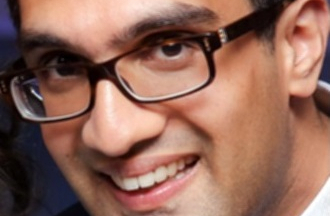
We invited Prof Siddharthan Chandran to be our keynote speaker at our Annual Conference and below we’ve provided a brief overview of his presentation which we hope you’ll find useful as either a recap if you attended or as an insight into MND and stem cells if you couldn’t make it on the day.
About Prof Chandran
Prof Chandran is Professor of Neurology at the University of Edinburgh and Director of the Euan MacDonald Centre for MND Research which is based at the university. He is leading the Association’s largest stem cell research programme which pulls together world-class researchers from leading institutes in Edinburgh, London and New York. Working together, the international research teams are manipulating stem cells to provide a unique tool for studying MND and developing new drugs. It’s research programmes like this, that really demonstrate our role as a leader in funding and promoting cutting-edge MND research. Naturally we were only too pleased to introduce Prof Chandran to our conference delegates.
Origins of understanding the power of stem cells
Prof Chandran began his talk on a mythological level with the story of Prometheus, who was punished by the Greek God Zeus by being chained to a rock and having his liver eaten daily by an eagle, only to have it grow back the next day to endure the torture again. Not a very nice story, but Prof Chandran went on to explain that through this myth, the Greeks had stumbled onto the origins of understanding the nature of stem cells. The liver is one of the only solid organs that we have that has the power to regenerate itself when damaged. Although this wasn’t the moral of the myth, it’s still an important historical reference that demonstrates that the potential of stem cells as a regenerative tool is not a new concept.
From science fiction to science fact
If Prof Chandran, while at university, had suggested that in the future it would be possible to create stem cells from a skin sample, he said that he would have been ridiculed and the idea would’ve been seen as pure science fiction. Yet here we are, now living in ‘the future’ and this technology is a reality, the newest finding of which was the discovery of stem cell-like cells called ‘induced pleuripotent stem cells’ (or iPS cells for short) in 2008 by a Japanese research group. By delivering a cocktail of chemicals to skin cells donated by a living person, they were able to turn back the clock of the skin cells to turn them into iPS cells. This finding is now the cornerstone of many new stem cell research projects, which has arguably revolutionised the field.
Future treatment potential, but currently regeneration is impractical
There are many ways that stem cells could be used in the future to treat MND, but using them to regenerate motor neurones is not currently a practical solution. But why isn’t this practical? In his talk, Prof Chandran explained…
Crossing wires
The brain is a very complex organ and can be related to a ball of wiring, with each wire being linked to a specific place within the brain and body. If this were to be wired up inaccurately, then it would cause pandemonium in our bodies, with movement instructions meant for our feet to possibly end in our hands, mouth or elbow for example – something we’d definitely not want to happen!
Prof Chandran went onto explain that each neurone has its own ‘postcode’ in the brain, and depending on where it ‘lives’, he explained that its function will vary.
The function of each motor neurone will also intuitively denote what muscle it’s supposed to connect to. The way that our neurones grow toward a muscle is an extremely well orchestrated affair, with chemical messages throughout the body that either attract, or repulse it. However, as our bodies develop in the womb, this system is switched off – meaning that any new motor neurones trying to grow from scratch in the brain will find it near to impossible to know where it’s supposed to go.
It is therefore a very complicated issue to try and regenerate motor neurones in humans to ensure that the motor neurone firstly starts in the right place, and secondly that the neurone has the right instructions in place to guide it toward its target muscle. However, these aren’t the only issues that researchers face…
Being sure it’s a motor neurone
In our search for using stem cells as a treatment for MND, there is also an issue of making sure that stem cells turn into the cells you want them to be, and Prof Chandran eloquently explained this by using a video of heart cells, generated using stem cell technology and saying that you definitely wouldn’t want these cells beating away in your brain instead of your motor neurones!
But how do researchers turn stem cells into the ‘right’ sort of cell? Prof Chandran explained that this is done quite simply, by giving them the right recipe of chemical ingredients to tell them what to become when they’re older.
Neurones are slow growers
Even if researchers could somehow ensure that ‘new’ motor neurones could be created and would connect to the right ‘postcode’ of the brain, neurones are very slow growing. As some of our motor neurones would have to grow over a metre to reach its target muscle, the amount of time that it would take to regenerate motor neurones would be implausible in terms of using them as a treatment. There just isn’t a way to speed this up at the moment.
For all of the above reasons, this is why stem cells cannot currently be used to regenerate motor neurones as a treatment for MND. However, this is not to say that they don’t have other uses…
Using stem cells to learn more about MND
Stem cells are great tools for recreating diseases in a dish, as they are able to divide to create large numbers of cells and are able to turn (with the right receipe) into any type of cell, such as a motor neurones.
In his laboratory, Prof Chandran’s research group have created living human motor neurones grown in a dish from skin cells donated by people with an inherited form of MND using iPS cell technology. In his presentation, he showed us that within 100 days, his laboratory is able to create a billion (1012, referred to as a trillion in USA) cells from a stem cell. He has also shown that these motor neurones generated from stem cells connect to muscle cells and are electrically active – which means that to all intents and purposes, they are real motor neurones.
He then explained that his MND Association funded project is creating these motor neurones and support cells from a skin biopsy of somebody with MND with faults in a gene called TDP-43. They can then use these new cells as a tool to investigate the disease process and hopefully in the future to test the effectiveness of therapies in this model.
Realising the potential of stem cells
As well as using stem cells to create new models in the laboratory, to discover new medicines, stem cells could potentially be used in a different way to treat the disease. These treatments would not aim to regenerate the motor neurones, but instead would attempt to slow down, or even stop the disease.
Realistically, researchers could use neurone support cells to provide a protective environment to lasting motor neurones – in fact, there are plans in place to test such a treatment which is estimated to being enrolling in 2014 (see stem cell conference blog article for more information).
Overall, Prof Chandran’s talk was extremely well received with delegates commenting to us that “Prof Chandran was the best speaker I can recall” and Prof Chandran’s talk was: “clear, hopeful, excellent. He inspired confidence and spoke in language I could understand”
We’re pleased that so many people who attended our AGM and Annual Conference enjoyed Prof Chandran’s talk, with 91.2% of delegates saying that it was “excellent” (from our survey of 57 people who attended).
Find out more about stem cells on our website.
Stay up-to-date with news on our next conferences by following our conference team on Twitter @mndconference



Comments are closed.